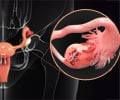Researchers say that simple transvaginal ultrasound scans can do away with invasive, expensive and time consuming hormone- based tests.
Researchers from Netherlands say that simple transvaginal ultrasound scans can do away with invasive, expensive and time consuming hormone- based tests, used for determining a woman’s success rate in IVF programs.
The researchers led by Janet Kwee from Vrije Universiteit Medical Center in Amsterdam carried out ultrasound tests on the ovaries of women subjects in an IVF program.IVF or in vitro fertilization in layman’s terms means the fertilization of sperms and eggs outside their natural settings.
Maximum number of follicles is stimulated to grow in a woman’s ovaries with the help of extra hormones and these are then ‘harvested’ for their subsequent fertilization with sperms.
Fertilization will be carried out in lab dishes before the embryos are implanted in the uterus.
As IVF is a substantially expensive option of assisted reproduction, a woman’s chance of success for IVF is determined beforehand, in order to advice for or against IVF.
Determining the chance of developing sufficient quantity and quality of the eggs by ovarian reserve tests or hormone tests does this. It is in this context that Kwee and team claim significance for their study findings.
Advertisement
Kwee counted the number of antral follicles, small egg-bearing ovarian follicles about 2-10 mm in diameter, with transvaginal sonography (ultrasound).
Advertisement
It was seen that the antral follicle count was an effective predictor of the number of eggs the patient would ultimately produce when her ovaries had been stimulated during IVF treatment.
Says Kwee, “The follicle count is just as good a test for ovarian response as expensive and time consuming endocrine tests."
The count appears to be "the only test able to reliably predict low and high responders", she adds.
The findings were reported in the journal Reproductive Biology and Endocrinology.
Source-Medindia
ANN








